How camping bans − like the one the Supreme Court just upheld − can fit into ‘hostile design’: Strat
Anti-camping laws are the centerpiece of the ‘hostile design’ strategies cities use to push the unhoused out of public spaces.
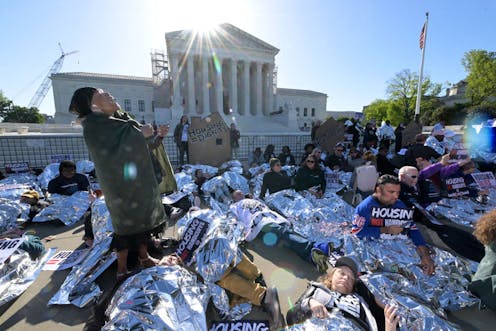
If you have no shelter and are arrested for sleeping outside, are you being punished for something you did – or for being homeless?
On June 28, 2024, the U.S. Supreme Court decided 6-3 that the Oregon city of Grants Pass may prohibit camping, even if there are no free shelter beds in the area. Critics have argued that this policy was a form of “cruel and unusual punishment,” in violation of the Eighth Amendment to the U.S. Constitution. A lower court agreed, saying it is unconstitutional to arrest people for a normal and necessary human behavior – sleeping – if there is nowhere else to go.
But Friday’s decision reversed that ruling. Such laws do not qualify as cruel, the court found, because they are not designed to inflict “terror, pain, or disgrace.” Nor are they uncommon. And they criminalize an action, the majority note, not the status of experiencing homelessness.
Advocates for unhoused people, however, argue these kinds of anti-camping laws effectively make homelessness a crime – and feared that a Supreme Court decision to overturn the ruling could intensify cities’ efforts to treat the unhoused as criminals.
As a professor of philosophy who studies homelessness, I believe it is important to understand camping bans as part of wider efforts to displace unhoused people. Cities do many things to assist people experiencing homelessness, providing everything from shelters to food pantries. Yet cities also use a variety of tactics to push unhoused people out of public view.
Perhaps the most revealing is “hostile architecture,” a focus of my research. This term is often used for public spaces designed in ways that discriminate against specific vulnerable populations. The most common examples are objects that present a physical barrier to everyday activities for people without housing.
Hostile design
One common example are spikes added to ledges to deter people from leaning or sitting. Since spikes are often quite noticeable, however, and their purpose is obvious, they occasionally elicit controversy.
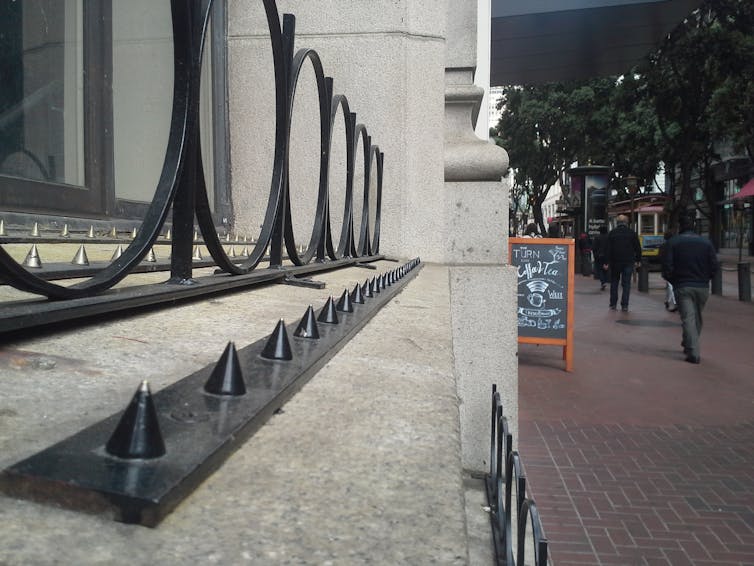
Another pervasive but less attention-grabbing form of hostile architecture are benches that have been redesigned to make them difficult or impossible to use as sleeping spaces. This is accomplished through a variety of design schemes that prevent people from lying down, from bucket seating or seat dividers to armrests.
Any number of other hostile physical obstructions can be found. Garbage cans are often fitted with hood designs, as well as external cases with built-in locks, to deter trash-picking.
Other designs alter the landscape itself. Bollards or boulders can be brought in to break up potential camping spaces. Fencing can be used to block off sheltered areas such as highway underpasses.
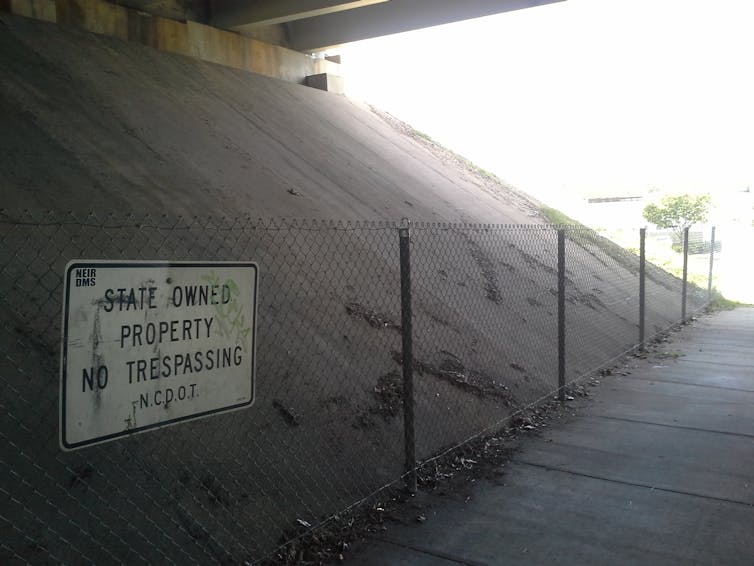
Hostile design isn’t always about objects; sometimes it involves actions, too.
Businesses and churches have been accused of regularly spraying water on potential sleeping spaces, sometimes via automatic sprinkler systems. Noise pollution can be another strategy, blasting loud music or annoying sounds to clear potential loitering places. Such was the case of a park in West Palm Beach, Florida, where the cloying children’s song “Baby Shark” was played along with other kids tunes each night.
Legal scholar Sarah Schindler argues that these kinds of hostile designs should be recognized as a form of regulation. As she puts it, “Regulation through architecture is just as powerful as law, but it is less explicit, less identifiable, and less familiar to courts, legislators, and the general public.”
Like the law, hostile architecture can have the effect of regulating people’s behaviors. But unlike the law, instances of hostile architecture are not subject to any kind of official oversight and often go unnoticed.
What’s there – and what’s not
Once you learn about hostile architecture, you start to see examples everywhere. But perhaps even more importantly, you also begin to notice the absence of certain items and services in public spaces.
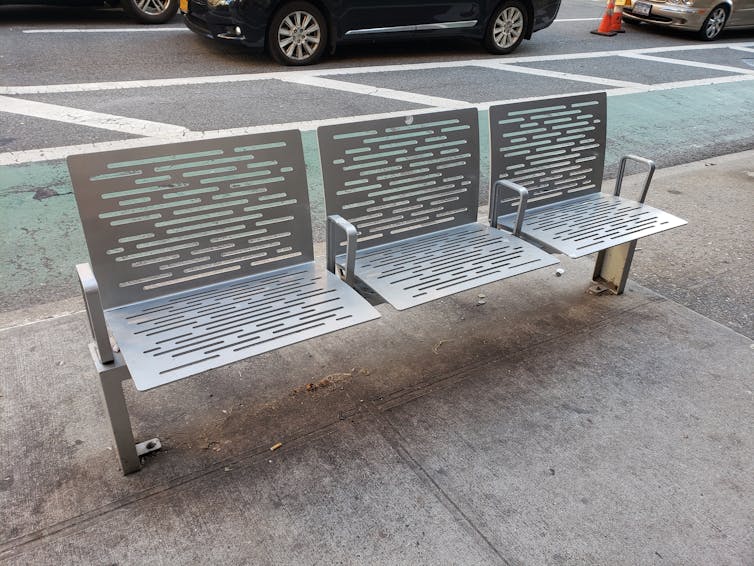
Rather than add armrests to a bench, the bench can be simply taken away. Trees can be removed to prevent loitering in the shade. Whole regions of cities are devoid of public restrooms, with options in private establishments available to paying customers only. Public space researcher Cara Chellew has come to refer to these conspicuously absent expected things as “ghost amenities.”
Hostile architecture, however, is only the tip of the iceberg. Just below the surface are the variety of laws that target particular behaviors: storing personal items in public space, loitering, panhandling and vagrancy. There are laws against sitting or lying down in public – so-called sit/lie laws. Anti-camping laws often apply not just to tents but to using any kind of covering at all, such as a blanket.
Even giving food to unhoused people is outlawed in some cities, if the individual or organization does not have a permit.
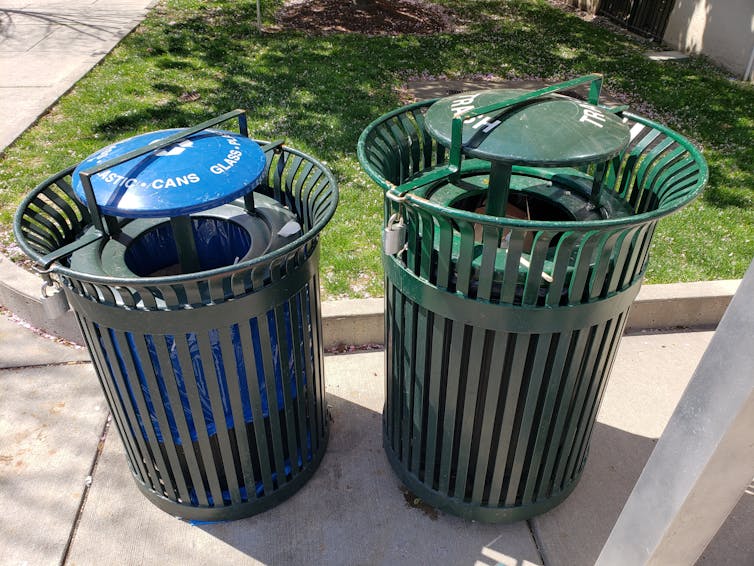
The National Homelessness Law Center has been charting the increase in these kinds of laws across the United States. In a review of 187 cities from 2006-2019, the center found a 78% increase in sit/lie laws and a 103% increase in laws against vagrancy, loafing and loitering. There was also a 92% increase in camping bans.
Informal policies can also serve as de facto bans on homelessness, such as when police pressure unhoused people to move along.
Many shelters, where they exist, are not open during daytime hours, leaving people without housing no choice but to loiter or continue moving throughout the day.
At times, shelters themselves present roadblocks that discourage people from using their services, such as patterns of discrimination against LGBTQ+ patrons or policies that ban pets.
Stakes at SCOTUS
On their own, many of these laws or objects may seem unobjectionable, or at least not a big deal. How much should we care about a bench with armrests, or a park with rules prohibiting sleeping?
When taken in the aggregate, however, these things can function together to exclude the unhoused from public space entirely. None of them literally make homelessness a crime – but in critics’ eyes, these laws and patterns of design have the same effect.
Justice Sonia Sotomayor, one of three to dissent from the majority’s decision in Grants Pass v. Johnson, raised a similar idea. The city’s camping ban punishes people for experiencing homelessness, she argued, leaving “the most vulnerable in our society with an impossible choice: Either stay awake or be arrested.”
This is an updated version of an article originally published on June 13, 2024.
Robert Rosenberger is currently serving as President of the Society for Philosophy and Technology.
Read These Next
What poll watchers can − and can’t − do on Election Day
Political parties sign up volunteers to observe what happens at polling places – which can improve…
Undoing the ‘deep state’ means Trump would undo over a century of progress in building a federal gov
Conservatives defend efforts to dismantle the federal bureaucracy as tactics against tyranny, but Americans…
No, America’s battery plant boom isn’t going bust – construction is on track for the biggest factori
The future of these job-generating gigafactories, many of them in Republican states, could be at risk…




